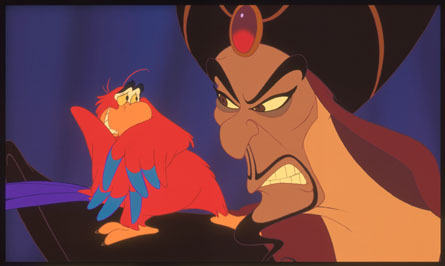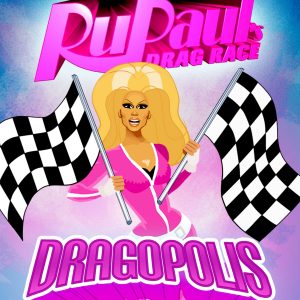If you were not aware (and I don’t blame you if you’re not), board games are in a sort of renaissance. In the past decade, board games have blown up all over the world and are becoming a popular phenomenon once again. This trend started in Europe, but soon enough spread outwards, reaching American shores first, and now is influencing Japanese game designers as well. Compared to video games and movies, board games are offering a new, compelling experience that you can only enjoy with your friends in person. Obviously you want to get in on this! However, before you dive on in, I am here to offer you some advice on where to get started.
Now, the first thing you need to know about board games is the lingo. “New” board games (that is, board games that have been made since the Settlers of Catan came out in 1995) fall under two major categories: American (sometimes referred to as “Ameritrash” [in the most loving of ways, of course]) and European (sometimes referred to as “Euro” or “Eurotrash” [again, in a totally loving way]). Generally, the separating factor between these two categories is that American games are heavy with theme. A popular example is Battlestar Galactica. BSG does everything in its power to make you feel like you’re a survivor on Galactica, trying to desperately to survive against hidden Cylon enemies. Many of the game mechanics were made to suit the theme. European games, on the other hand, put mechanics first. A Euro example would be Dominion, which has you building your kingdom by adding cards to your deck. Sometimes this makes sense, like buying new provinces, but sometimes you buy a feast and use it over and over again and if you think about the implications of that too much you might not buy feasts again.
Within these two categories there are several genres:
Deckbuilding Games
Deckbuilders are categ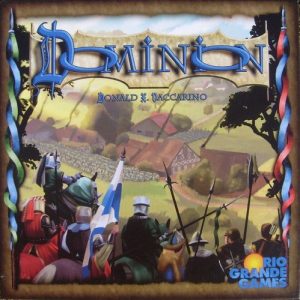 orized as board games, but they’re more like card games. Generally the idea is that you have a deck of basic cards which you can use to buy more powerful cards to add to your deck, building it up (see what they did there?). The original (and still one of the more popular) deckbuilding games is Dominion, mentioned above. Dominion has you buying from fifteen different card piles which change every game, as well as standard better money and land. Land don’t do anything in your hand, but are worth points at the end of the game. Once the game is over (after the best kind of land, the provinces, pile is depleted or three other piles are empty), the game ends.
orized as board games, but they’re more like card games. Generally the idea is that you have a deck of basic cards which you can use to buy more powerful cards to add to your deck, building it up (see what they did there?). The original (and still one of the more popular) deckbuilding games is Dominion, mentioned above. Dominion has you buying from fifteen different card piles which change every game, as well as standard better money and land. Land don’t do anything in your hand, but are worth points at the end of the game. Once the game is over (after the best kind of land, the provinces, pile is depleted or three other piles are empty), the game ends.
Dominion is more about creating a more efficient engine than your opponents (though some expansions change this dramatically), so if you want a more interactive experience, Ascension is a more American take on the genre. You get a basic deck of spellcasters and fighters and use them to summon more powerful heroes and defeat monster s. Instead of all cards available to you at once, however, there are only six cards available at a time. With this limitation, there is a greater emphasis on buying or destroying cards that you know your opponents want. Both are great games, and both are a wonderful introduction to deckbuilding games.
s. Instead of all cards available to you at once, however, there are only six cards available at a time. With this limitation, there is a greater emphasis on buying or destroying cards that you know your opponents want. Both are great games, and both are a wonderful introduction to deckbuilding games.
Worker Placement
Worker placement games are mainly European games. The basic premise is that you have a limited number of workers. Each turn, you send these workers out to gather resources or do jobs for you. The catch is that when you send a worker to do something, that action is now blocked off from your opponents.
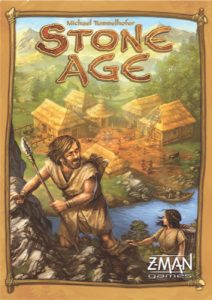 A basic worker placement game is Stone Age. Stone Age sees each player as a tribe simply struggling to survive. You start with five workers who you can send to gather food, resources, or build huts (which give points). You can also send two workers to “create” a new worker, but you have to feed your workers each turn, so the more workers you have, the more you can do, but the more food you have to gather. It’s a simple concept but very in-depth. I would recommend it as a great game to start learning about worker placement.
A basic worker placement game is Stone Age. Stone Age sees each player as a tribe simply struggling to survive. You start with five workers who you can send to gather food, resources, or build huts (which give points). You can also send two workers to “create” a new worker, but you have to feed your workers each turn, so the more workers you have, the more you can do, but the more food you have to gather. It’s a simple concept but very in-depth. I would recommend it as a great game to start learning about worker placement.
Co-operative Games (with or without Traitors)
But games don’t always have to be about competition! 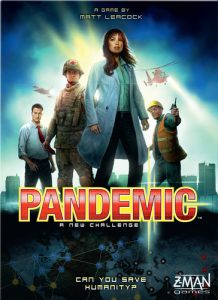 Sometimes you want to work together to solve a problem, and that’s fun too! Pandemic is a good example of a classic co-op board game that is great for beginners. Players band together as scientists trying to eradicate four deadly diseases before they infect the world. Pandemic does have some problems, though, including the same problem that a lot of co-op games have, referred to as “quarterbacking.” Quarterbacking is when one player “figures out” the game and basically tells everyone else what they need to do. This is a complex problem common to a lot of board games. Usually the player who is quarterbacking is just trying to be helpful, but it can make the other players feel like they’re not actually playing the game. On the other hand, if the player doesn’t quarterback when he knows how to win, then he’s not helping the team, which is what you should be doing
Sometimes you want to work together to solve a problem, and that’s fun too! Pandemic is a good example of a classic co-op board game that is great for beginners. Players band together as scientists trying to eradicate four deadly diseases before they infect the world. Pandemic does have some problems, though, including the same problem that a lot of co-op games have, referred to as “quarterbacking.” Quarterbacking is when one player “figures out” the game and basically tells everyone else what they need to do. This is a complex problem common to a lot of board games. Usually the player who is quarterbacking is just trying to be helpful, but it can make the other players feel like they’re not actually playing the game. On the other hand, if the player doesn’t quarterback when he knows how to win, then he’s not helping the team, which is what you should be doing 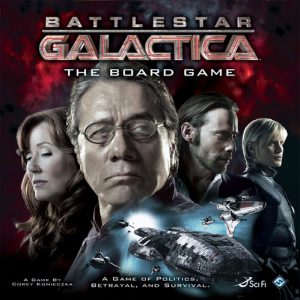 in a co-op game! More recent co-operative board games have tried to circumvent the quarterbacking problem. Battlestar Galactica is one of those board games.
in a co-op game! More recent co-operative board games have tried to circumvent the quarterbacking problem. Battlestar Galactica is one of those board games.
As described earlier, BSG casts players as crew member aboard Galactica, fighting off Cylons and just trying to survive on the way back to Earth (as a side note, actual knowledge of the show is unnecessary. I haven’t watched a single episode and I love it). The way that BSG gets around the quarterbacking issue, however, is that the person telling you what to do might actually be a Cylon. You see, at the beginning of the game, each player gets a Loyalty card that says if they are a Cylon or not. Then, halfway through the game, players get a second Loyalty card. Halfway through, you might wake up as a Cylon! Co-op games with a traitor element are a great way to spread mistrust through the group, and if you don’t trust the person trying to give you advice, well, why follow it?
Battlestar Galactica, by the way, is a great game to start with if you’re just getting into the hobby, but it requires a larger group (at least 5 players), can be complicated, and does take at least a couple of hours to play.
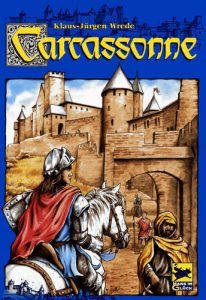 Tile-Laying Games
Tile-Laying Games
Not really it’s own genre, but more one gameplay mechanic that fits into lots of games. It is, however, the primary mechanic for the game Carcassonne, another great game for someone beginning to play board games. In it, you lay tiles (who knew!) trying to make complete roads and cities. You can park your little people icons (“meeples”) on half-finished cities or roads to block them off and score points when the location in competed. It’s also a great way to feel burning hatred when one of your so-called “friends” blocks off your city, making sure it will never be complete and your wooden person will be stranded for eternity. Carcassonne can be vicious sometimes, but that’s part of what makes it great!
“It’s Complicated” Games
Now here’s where I drop a bomb on you. All of these things I have been calling “genres” are more like “mechanics.” That is, you see very few games these days that are “just” worker placement. Rather, you have games—like Archipelago, which combines worker placement, resource management, tile-laying, and semi-cooperation—that mix and match different gameplay mechanics to make a truly unique experience, even if it shares mechanics with another game. Another example is Dungeon Lords, which combines worker placement, tile-laying, and resource management just like Archipelago, but goes about it in a completely different way. It’s hard to pin down genres in this era of board games, and honestly, that’s okay! Board games are trying to make themselves stand out from each other, and this makes for incredibly entertaining experiences. 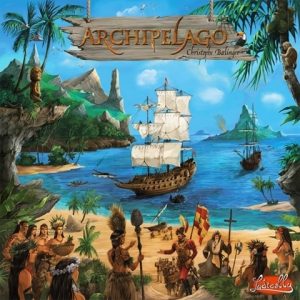
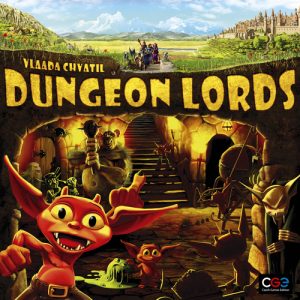 Or, at least, it can. Which brings me to…
Or, at least, it can. Which brings me to…
Games to Be Wary of
I was going to call this “games to avoid,” but that seems a bit too strong. I don’t think you should run the other way screaming if someone were to bring one of these games out, but you should definitely keep in the back of your mind whilst playing these games that they are not indicative of the hobby as a whole. There are three games that stick out in my mind. Those three are The Settlers of Catan, Munchkin, and Arkham Horror. I mention these three specifically for a couple reasons, one of them being that each game has its own fairly large following, so if you tell a friend that you want to get into board games, there’s a good chance that they own one of these three and want you to play it. The other reason is that these three do offer something to a new player. They’re either easy to learn or are absolutely dripping with theme, two things that draw new players in. But, well…
The Settlers of Catan’s biggest problem is that it’s a relic of the times. Like I said before, it was made in 1995 and sort of kicked off the whole board gaming revolution. However, board games have changed a lot in the eighteen years since then! The game itself has 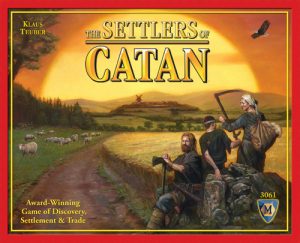 you building a town, gathering resources and trading with other players, trying to make the biggest and best. The two main mechanics of gathering resources and trading don’t really work that well, though. To gather a resource, you have to rely on a specific dice roll coming up, and if it doesn’t…tough. You could trade, but unless you have something you know someone else wants, chances are you aren’t going to get what you need. It also can be a long game (especially with the expansion that makes the maximum number of players six instead of four, oy). Settlers is not a bad game, per se. I don’t even think it’s a terrible choice for your first taste of modern board games. It’s just not something I want to play again. I played it once, had my eyes opened to what board games are now, and, well, that was enough for me.
you building a town, gathering resources and trading with other players, trying to make the biggest and best. The two main mechanics of gathering resources and trading don’t really work that well, though. To gather a resource, you have to rely on a specific dice roll coming up, and if it doesn’t…tough. You could trade, but unless you have something you know someone else wants, chances are you aren’t going to get what you need. It also can be a long game (especially with the expansion that makes the maximum number of players six instead of four, oy). Settlers is not a bad game, per se. I don’t even think it’s a terrible choice for your first taste of modern board games. It’s just not something I want to play again. I played it once, had my eyes opened to what board games are now, and, well, that was enough for me.
 Munchkin, on the other hand, is not a game I can recommend. It seems so simple! Deceptively so, in fact. Each turn, a player knocks down a dungeon door and fights the monster within. If you win, you gain a level and possibly some items. The first person to reach level ten wins. Simple, right? Well, yes, but the trouble is you get cards to prevent others from winning. Basically the game devolves into “this person will win if they kill this monster, so I have to play these cards to make sure they don’t, which means the next person who goes is going to win because everyone used their cards on the last guy.” It’s also long. Soul-crushingly long. The game will be over long before anyone will be crowned the winner. The worst part is that in the end the game isn’t really fun. It’s too simple and too basic to derive any real pleasure from it. People say it’s a great game to play while having a drink and laughing with friends, but really, you can do that with a good game as well.
Munchkin, on the other hand, is not a game I can recommend. It seems so simple! Deceptively so, in fact. Each turn, a player knocks down a dungeon door and fights the monster within. If you win, you gain a level and possibly some items. The first person to reach level ten wins. Simple, right? Well, yes, but the trouble is you get cards to prevent others from winning. Basically the game devolves into “this person will win if they kill this monster, so I have to play these cards to make sure they don’t, which means the next person who goes is going to win because everyone used their cards on the last guy.” It’s also long. Soul-crushingly long. The game will be over long before anyone will be crowned the winner. The worst part is that in the end the game isn’t really fun. It’s too simple and too basic to derive any real pleasure from it. People say it’s a great game to play while having a drink and laughing with friends, but really, you can do that with a good game as well.
Arkham Horror has the biggest “Be Wary” sticker on it. Again, like Settlers, not because it’s a bad game. Rather, it’s a very complex game. It is a co-operative game where players play as investigators in the New England town of Arkham, where Cthulhu, Nyarlathotep, or some other eldritch evil is trying to awaken. Obviously, you have to make sure that that doesn’t happen. So what makes it something to be wary of? For starter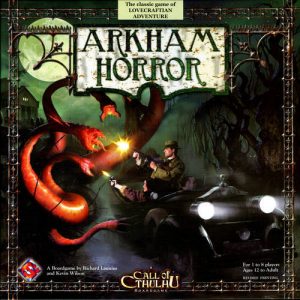 s, it has one of the worst-written rulebooks I’ve ever read (and as you learn more about board games, you’ll realize that this is “a thing” with Fantasy Flight Games), so learning the game on your own is an exercise in trying to figure out which rules you got wrong. If you want to play, I recommend finding someone who already knows the game and getting them to teach you. Another mark against it is that like Settlers, it’s a highly random game. I once spent the first half of a game of Arkham failing basically every single thing I tried to do because the dice just didn’t want to be on my side. It’s also a very long game. Boardgamegeek.com tells me that the average playing time is around four hours. Ouch.
s, it has one of the worst-written rulebooks I’ve ever read (and as you learn more about board games, you’ll realize that this is “a thing” with Fantasy Flight Games), so learning the game on your own is an exercise in trying to figure out which rules you got wrong. If you want to play, I recommend finding someone who already knows the game and getting them to teach you. Another mark against it is that like Settlers, it’s a highly random game. I once spent the first half of a game of Arkham failing basically every single thing I tried to do because the dice just didn’t want to be on my side. It’s also a very long game. Boardgamegeek.com tells me that the average playing time is around four hours. Ouch.
Conclusion
But! If any of these games sound interesting to you, even the ones I don’t like as much, I say go out and try them! Maybe you’ll play them and really enjoy yourself. Maybe you’ll pick up Battlestar Galactica and decide it’s not the game for you. That’s okay! Try what sounds interesting and see what you like. Now, I say try, because board games can be expensive. As a tip, though, from what I’ve seen, the people playing them and the stores that sell them want you to play them. Here in San Francisco, one of my local game stores has a board game night every week where they open their gaming closet and let you play away. For free, even! I say go out, ask around, and try playing some board games. In addition, definitely do some research before you decide to buy something. If you hear about a game, try looking it up on Boardgamegeek.com or Shut Up & Sit Down. Both places have plenty of resources and reviews. You can also find practically every game’s rulebook online as a PDF if you want a quick readthrough. And if you’re still unsure, there is a recent trend of board games showing up on iOS for a fraction of the cost! Most of the board games I mentioned are available for $10 or less. The biggest thing, though, is to have fun. That is, after all, what board games are about.


![pandbed[1]](https://gaymerx.org/wp-content/uploads/2013/05/pandbed1.jpg)

